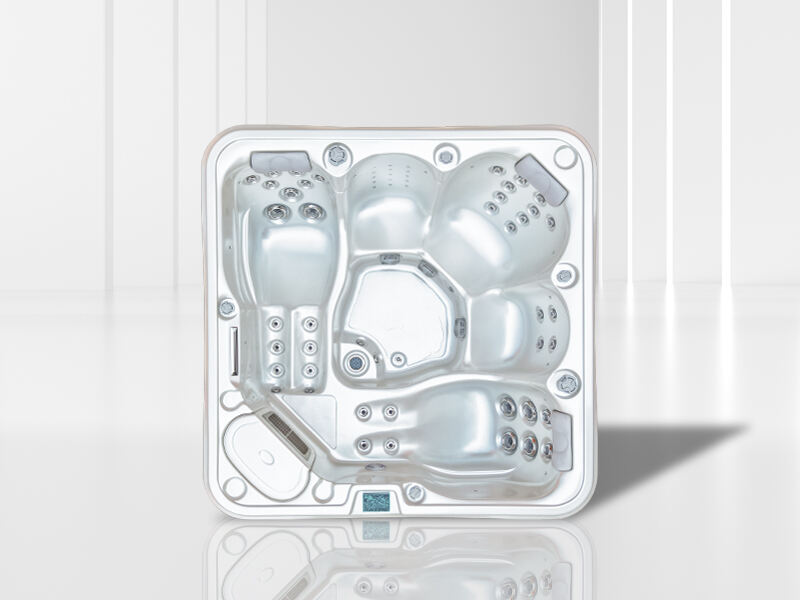Choosing the Right Spa Pool for Your Space
Selecting the ideal spa pool involves balancing available yard dimensions, functional requirements, and aesthetic preferences. Industry analyses reveal that 68% of buyers prioritize spatial compatibility over features (Backyard Wellness Report 2024). Evaluate your yard's topography, intended use frequency, and local climate alongside design trends.
Comparing Hot Tub Types: From Compact to Swim Spas
Portable "plug-and-play" models suit spaces under 6x6 ft, while premium acrylic units (8x8 ft+) offer integrated seating for 5-7 adults. Swim spas—typically 15-19 ft long—provide dual aquatic therapy and resistance swimming zones.
Space Requirements: Matching Pool Size to Yard Dimensions
Measure your installation area with minimum clearances:
- Surrounding Access: 2 ft clearance on three sides
- Overhead Lines: 10 ft vertical clearance
- Foundation Depth: 6-inch reinforced slab for units >500 lbs
2024 Design Trends in Outdoor Wellness Spaces
Innovations emphasize:
- Minimalist Integration: Recessed spas with flush-to-deck covers
- Biophilic Elements: Native plant privacy screens
- Smart Lighting: Color-changing LED systems with circadian rhythm programming
Spa Pool Installation Essentials
Electrical Specifications for Safe Operation
All spas require dedicated 240V circuits with GFCI protection per NEC Article 680. A licensed electrician must verify panel capacity and wire gauge—#6 AWG copper for runs over 50 feet.
Foundation Preparation: In-Ground vs. Above-Ground Options
In-ground installations increase costs by 30-50% compared to prefabricated above-ground pads. Concrete slabs (4" minimum thickness) remain the standard, supporting up to 165 PSI.
Access Planning for Delivery and Maintenance
Ensure 48"-wide pathways for spa transport and future component replacement. Maintain 36" service corridors around three sides for filter access and motor repairs.
Spa Pool Water Maintenance Strategies
Sanitization Systems: Chlorine vs. Saltwater
Chlorine remains the most widely used sanitizer, though 43% of owners report skin irritation from improper dosing (Water Quality Association, 2023). Saltwater systems generate chlorine through electrolysis, reducing manual handling.
pH Balancing: Avoiding Common Chemical Mistakes
Maintain a pH range of 7.2–7.8. Always balance total alkalinity first (80–120 ppm) before fine-tuning pH. Digital testers show 94% accuracy in lab trials.
Winterization Techniques for Year-Round Use
Thermal covers reduce heat loss by 60%, while antifreeze solutions protect plumbing down to -20°F. Monthly winter checks include inspecting jets, testing chemistry, and replacing 25% of water pre-season.
Spa Pool Health Benefits and Hydrotherapy
Muscle Recovery: Jet Configuration Science
Adjustable 360-degree jets enable personalized settings, improving recovery speed by 25% compared to static immersion (International Journal of Sports Medicine 2022).
Stress Reduction Through Thermal Therapy
Heated aquatic environments lower cortisol levels by 17%, enhancing parasympathetic nervous system activity.
Low-Impact Aquatic Exercise Options
| Activity | Caloric Burn (30 mins) | Primary Benefits |
|---|---|---|
| Aqua Jogging | 240 calories | Non-compressive cardio enhancement |
| Resistance Band Work | 180 calories | Muscle toning with low-joint impact |
| Aquatic Yoga | 150 calories | Flexibility/lumbar decompression |
Water’s viscosity creates 12x greater resistance than air, enabling strength gains without injury risks (Arthritis Foundation 2023).
Landscaping Around Your Spa Pool
Privacy Screen Designs for Relaxation Spaces
Natural screening options like bamboo clusters or arborvitae hedges provide year-round coverage.
Decking Materials That Complement Hot Tubs
Composite decking dominates 57% of new installations (Outdoor Living Trends Report 2024) due to slip-resistant textures.
Lighting Schemes for Evening Ambiance
Three-tier lighting prevents glare:
- Submerged LED benches (3000K warmth)
- Directional spotlights highlighting plants
- Motion-activated path markers
Energy Efficiency in Spa Pool Operation
Insulation Technologies for Heat Retention
Multi-layer foam insulation and thermal covers minimize heat loss. Energy-efficient models maintain temperature 40% longer (Department of Energy 2023).
Smart Timer Systems for Cost Management
Wi-Fi-enabled smart timers reduce standby energy waste by 25% while integrating with weather forecasts for proactive adjustments.
FAQ
What are the standard electrical requirements for a spa pool?
All spa pools require a dedicated 240V circuit with GFCI protection according to NEC Article 680. A licensed electrician should verify panel capacity and use #6 AWG copper wire for runs over 50 feet.
What foundation type is recommended for a spa pool?
The preferred foundation for a spa pool is a concrete slab with a minimum thickness of 4 inches, which can support up to 165 PSI. This type of foundation is especially crucial for above-ground spa installations.
How often should spa water chemistry be checked?
Spa water chemistry should be tested and adjusted regularly. During the winter months, check monthly, inspecting jets, testing chemical levels, and replacing about 25% of the water pre-season.

